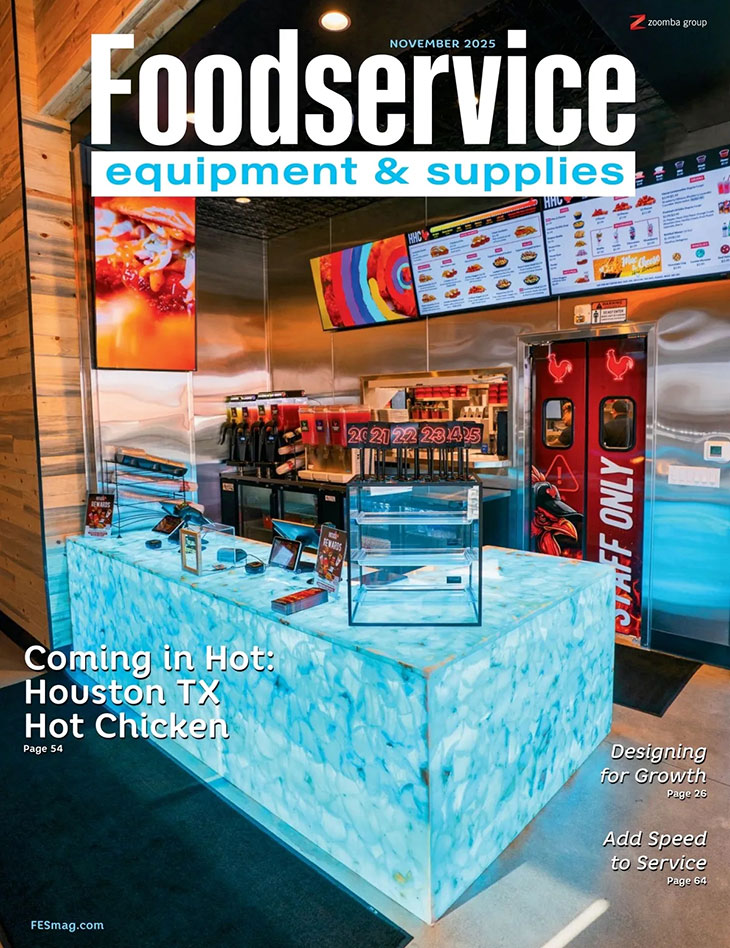Plus, technology’s role in restaurants’ recruitment and retention efforts. Middleby brews a new division. Consumer outlook takes a turn.
 Image courtesy of Nathan’s FamousAfter spending much of last year focused on building customer traffic through value meals, limited time offers and more, restaurant chains seem to be turning their attention to the design of their physical locations as a way of boosting their businesses.
Image courtesy of Nathan’s FamousAfter spending much of last year focused on building customer traffic through value meals, limited time offers and more, restaurant chains seem to be turning their attention to the design of their physical locations as a way of boosting their businesses.
For example, the new design for Nathan’s Famous channels the chain’s New York City roots. Its new free-standing restaurant design features “modern New York City loft-style elements next to classic features of historic architecture,” per a company release. The unit, which opened in Rock Hill, S.C., also includes a double drive-thru.
And a refreshed footprint is on the menu for Applebee’s, too. The casual dining chain purchased 47 franchised locations and plans to remodel 30 of them as part of its “Looking Good” reimaging program, per an FSR story. The company believes it can revitalize and refresh the restaurants and spin them back to operators in roughly three years — increasing the value of the stores in the process.
Finally, Starbucks hopes a new design will encourage customers to sit a while and sip their coffee. The Seattle-based coffee chain grew in popularity, in part, by becoming that “third place” that gave customers a place to go that was not work or home. Lately, though, Starbucks has become more transactional as the chain emphasized mobile ordering and redesigned some of its stores to better serve off-premises customers. Starbucks is testing a design that aims to revive its third-place concept by offering expanded seating options and more power outlets to encourage longer stays. That said, Starbucks is not turning its back on mobile order customers. The design includes a dedicated pickup area as well as risers and pickup shelves to better organize off-premises orders. This is part of CEO Brian Niccol’s “Back to Starbucks” plan and it comes shortly after the chain rolled out ceramic mugs and free refills for customers who choose to enjoy their beverages on-premises.
Foodservice News
- McDonald’s is changing its thinking to better compete against single-minded concepts. The chain formed a Restaurant Experience Team to make McDonald’s more competitive against concepts that may specialize in one menu segment like beverages or chicken, per various published reports including this one from Restaurant Business. The company is working on several chicken items, such as its snack wrap. And McDonald’s is honing its beverage business through its CosMc’s concept. This approach aims to speed McDonald’s decision-making as the chain adds more technology to its restaurants.
- Craveworthy Brands’ restaurant portfolio just got a little sweeter. The multiconcept operator acquired Kinnamōns, an Oregon-based cinnamon roll concept founded by longtime professional football player Ndamukong Suh. Kinnamōns also offers espresso and flavored coffees. Craveworthy Brands feels the concept is ready to scale nationally, per a release announcing the deal.
- Middleby has formed The Middleby Brewing & Distilling Solutions Group. The group aligns a handful of Middleby brands: equipment and processing solutions from Deutsche and Ss Brewtech along with canning, bottling, dispensing equipment and tap systems from Wild Goose Filling, Meheen, Cervizi, and NexDraft. The group will be able to provide “specialized, custom, and comprehensive” solutions based on specific customer release, per a company release.
- Wonder Restaurant Group continues to acquire the parts necessary to achieve its goal of being consumers’ “super app for mealtime.” The delivery-focused restaurant organization has acquired the media company Tastemade. The plan is to create a media network that will combine Tastemade’s brand storytelling capabilities and digital audience with Wonder’s first-party data and delivery capabilities. Tastemade’s audience totals 160 million followers across social media and 13 million monthly users across streaming channels, per a Marketing Dive story.
- Can the use of technology help restaurant operators solve their labor woes? Data from the National Restaurant Association says yes. “More than 80% of restaurant operators say that technology gives them a competitive advantage, and we’re seeing that in hiring,” said Dr. Chad Moutray, the NRA’s vice president of Research and Knowledge. “By integrating automation and AI-powered tools, restaurants are reducing hiring times, enhancing employee engagement, and fostering a workplace culture that supports long-term retention.” He cited data from the NRA’s Workforce Technology Research Insights report, which explores the role AI and other forms of technology can play with recruiting and retaining employees.
- Everyone talks about them but what goes into a successful foodservice partnership? The parties involved need to have trust in their roles and the others involved, a shared vision, clarity on compensation and an understanding of risk tolerance. That’s the sage advice of longtime restaurant consultant Matthew Mabel of Surrender, who goes into greater detail in this post. Given that partnerships are like marriages in that they are easy to get into and hard to get out of, as Mabel points out, having everyone involved on the same page with these four elements seems prudent for any foodservice relationship.
Economic News
- February U.S. retail and foodservice sales increased 0.2% compared to the previous month, per data from the U.S. Census Bureau. While these results did not meet most economists' projections, the news was not all bad, as this Yahoo! Finance story explains, thanks to a relatively stable jobs market. This represents a 3.1% increase from February of 2024. For the first two months of the year, sales at eating and drinking places are up 1.5%. Total sales for the December 2024 through February 2025 period were up 3.8% from the same period a year ago.
- Consumer sentiment tumbled significantly in March. The University of Michigan Index of Consumer Sentiment came in at 57.9, a 10.5% decline from the previous month. Dow Jones had projected the study to come in at 63.2, per CNBC. The one-year inflation outlook climbed 4.9%, its highest level since November 2022. While this study will often differ by political party, the university notes that sentiment declined across all demographics.
- The Consumer Price Index increased 0.2% in February, the U.S. Bureau of Labor and Statistics reported. Over the last 12 months, the CPI increased 2.8%. This is 0.1% less than economists had projected, per a Yahoo! Finance story. For the month, food away from home (restaurant) prices increased 0.4%, while food at home prices (groceries) were flat. For the 12 months ending in February 2025, restaurant prices increased 3.7% compared to 1.9% for grocery prices.
- The Producer Price Index for final demand grew 0.6% in February, the U.S. Bureau of Labor Statistics reported. Given that January’s increase was 0.5%, the bureau views February’s PPI as being unchanged from the previous month. The index for final demand advanced 3.2% for the 12 months ending in February. In February, a 0.3% increase in prices for final demand goods offset a 0.2% decline in the index for final demand services.
- Initial jobless claims declined by 2,000 for the week-ending March 8, 2025, per the U.S. Department of Labor. That’s less than 226,000 analysts had projected, per ABC News, and signals a still-healthy jobs market. The 4-week moving average was 226,000, an increase of 1,500 claims.
- The housing market offered some mixed results in February. For example, permits for future construction of single-family homes declined 1.2% in February compared to the previous month, per data from the U.S. Census Bureau. February’s level of 1.45 million is also 6.8% less than the same month in 2024. This reflects builders’ concern about the looming tariffs and other economic headwinds on the horizon, per a Yahoo! Finance story. In the plus column, February housing starts increased 11.2% compared to January, which shows builders are motivated to get moving before the economic environment changes.



